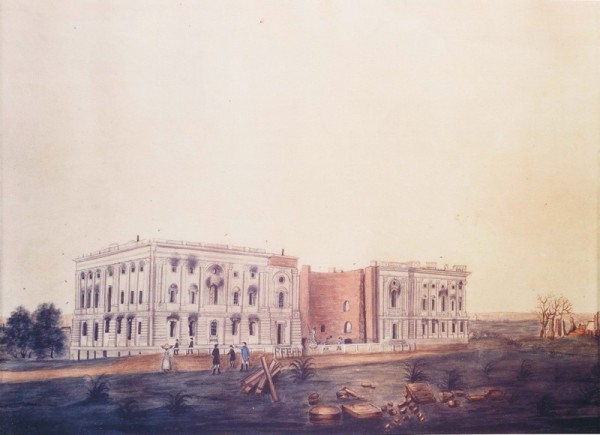
George Munger, The Capitol in Ruins, 1814–1815. Watercolor on paper. 12" x 17". (Courtesy, Kiplinger Washington Collection.) The fire of August 24, 1814, greatly compromised the Capitol’s structural integrity. Congress could not reoccupy the building until the end of 1819.

Advertisement, New-York Evening Post, October 30, 1817. Constantine was not the only cabinetmaker on his block. Duncan Phyfe and his former apprentice Robert Kelly also operated businesses on Fulton Street.
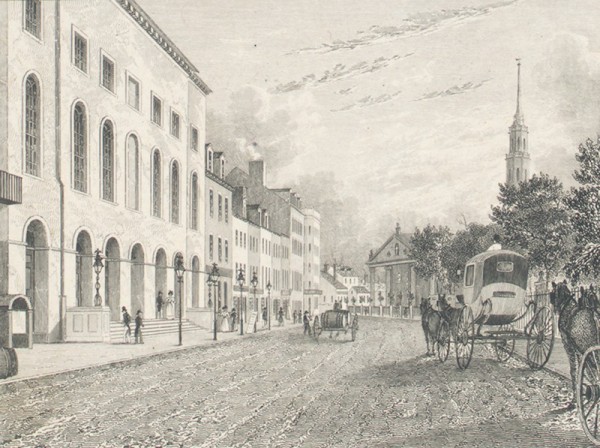
James Smillie after Charles Burton, St. Thomas’ Church, Broadway, New York, Park Theatre, and Part of Park Row, 1831. Etching. 3 5/8" x 2 3/4". (Courtesy, I. N. Phelps Stokes Collection, Miriam and Ira D. Wallach Division of Art, Prints and Photographs, New York Public Library, Astor, Lenox and Tilden Foundations.) Constantine opened his Fulton Street wareroom a half block from Broadway and City Hall. St. Paul’s Church is visible at the intersection of Broadway, Fulton, and Park Row.

T. Constantine & Co., pier table, New York City, 1817–1820. Mahogany, mahogany veneer with white pine and tulip poplar; marble, mirrored glass, gilded gesso, verde antique, and brass. H. 35", W. 42", D. 19". (Courtesy, Brooklyn Museum.) This table is one of a pair owned by wealthy Bristol, Rhode Island, merchant James De Wolf.
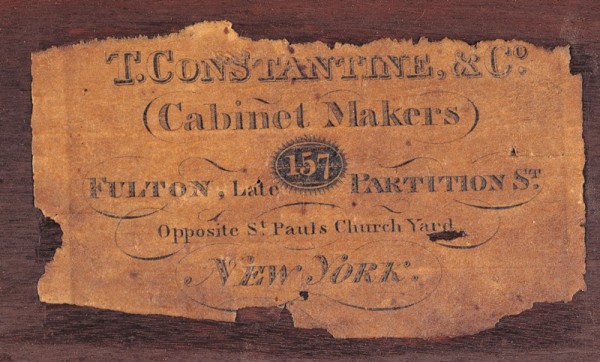
Detail of the label on the pier table illustrated in fig. 4. This is the only paper label associated with T. Constantine & Co. and was probably printed in 1817, when Constantine first moved to Fulton Street.

David Davidson, Interior of the Mount, Bristol, Rhode Island, ca. 1880. Photograph. (Courtesy, Historic New England.) The pier table illustrated in fig. 4, or its mate, can be seen between the windows on the opposite wall. The table is also shown in A Bit from the de Wolf House, a ca. 1860 painting by Worthington Whittredge (1820–1910).
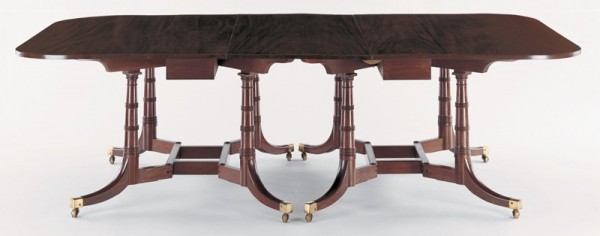
T. Constantine & Co., drop-leaf dining table, New York City, 1817–1820. Mahogany with white pine and maple. H. 28 1/2", W. 59 3/4", L. 118 1/4" (extended). (Private collection.) Though “Cumberland Action” dining tables are typically attributed to Thomas Seymour of Boston, this example bears Constantine’s label.
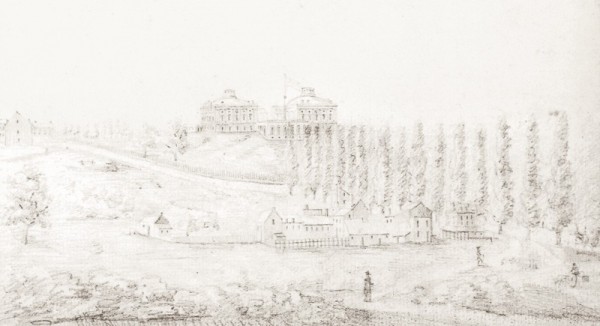
Michael Esperance de Hersant, View of the Capitol Looking Southeast, ca. 1819. Drawing on paper. (Private collection.) This is one of the few views of the Capitol during the period before the central rotunda was completed. When T. Constantine & Co.’s furniture arrived in Washington in 1819, the Capitol would have been in this state of continuing construction.

The Old Capitol Prison, 1st and A Streets, NE, Washington, D.C., 1862–1865. (Courtesy, Library of Congress.) While the Capitol was reconstructed between 1814 and 1819, Congress met in this former tavern (nicknamed the Brick Capitol), for which Latrobe designed an addition that included assembly rooms for the House and Senate.
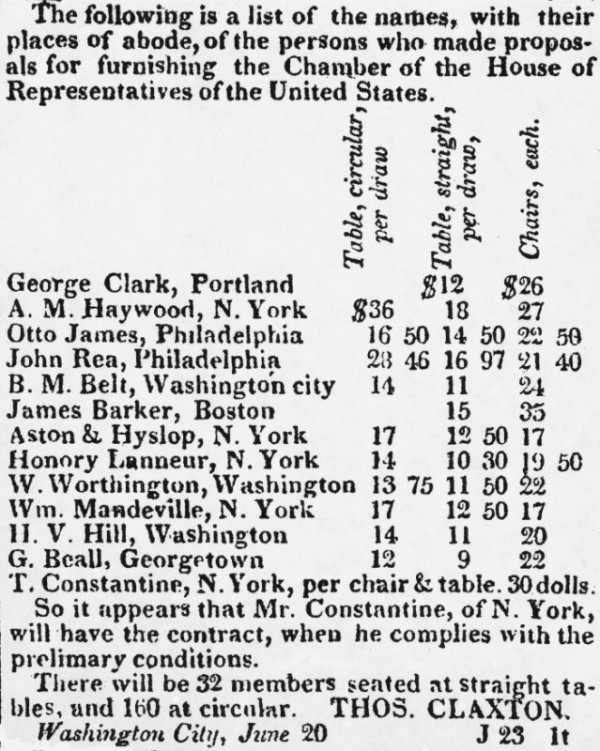
Advertisement, Mercantile Advertiser (New York), June 23, 1818. Constantine’s successful bid for the House commission was announced in newspapers in Washington, Baltimore, Philadelphia, and New York. The name “Honory Lanneur” is a misspelling of Honoré Lannuier.

Charles-Honoré Lannuier, armchair, New York City, 1812. Mahogany and mahogany veneer with cherry and white pine; die-stamped brass, inlays. H. 36 3/8", W. 23 3/8", D. 22 1/2". (Courtesy, Collection of the City of New York, City Hall; photo, Bruce White © 1998 The Metropolitan Museum of Art.) Lannuier produced a set of twenty-four armchairs for the Common Council Chamber at New York’s City Hall. He charged $336 for the chairs, which were upholstered by Henry Andrew (active 1809–1825) of New York.

Carlo Franzoni, Car of History, Washington, D.C., 1818–1819. Marble. Dimensions not recorded. (Courtesy, Office of the Architect of the Capitol.) Simon Willard provided the movement for this sculpture, which sits above the north entrance to the House chamber, now Statuary Hall.
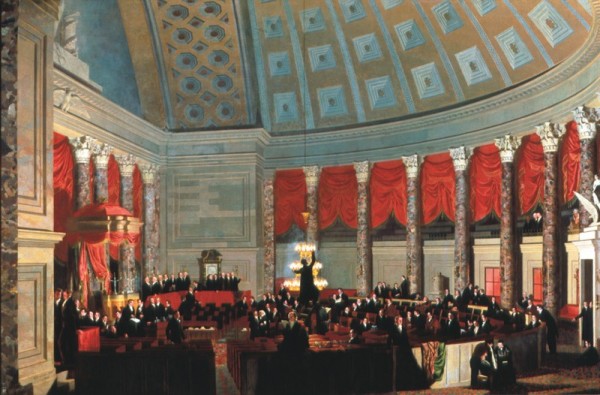
Samuel F. B. Morse, The House of Representatives, 1822–1823. Oil on canvas. 86 1/2" x 130 3/4". (Courtesy, Corcoran Gallery of Art, Washington, D.C., Museum Purchase, Gallery Fund.) Morse painted this epic work less than four years after the House of Representatives chamber was furnished. Though the painting depicts a fictional gathering of representatives, Supreme Court justices, and visiting dignitaries, Morse’s representation of the room was accurate. The left side of Franzoni’s Car of History can be seen at the far right.
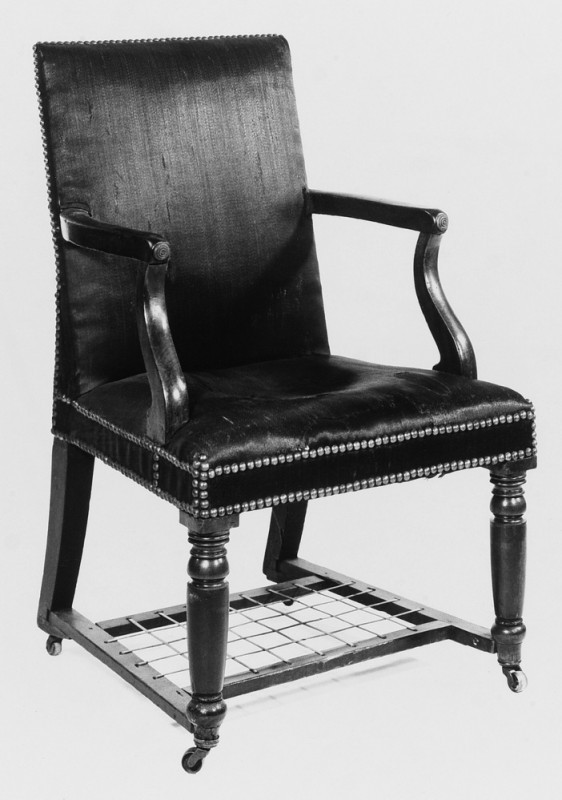
T. Constantine & Co., armchair, New York City, 1819. Mahogany and mahogany veneer with ash, white pine, and maple. H. 37 1/2", W. 23", D. 19". (Courtesy, National Museum of American History, Smithsonian Institution.) This is one of two House of Representatives chairs that retain the T. Constantine & Co. label. The stretchers and woven hat rack were added after the chairs arrived in Washington.

Detail of the right leg of the armchair illustrated in fig. 14. The simple turning sequence at the top of the leg provided a unifying design for the representatives’ chairs and desks.

Armchair, New York City, 1788–1789. Mahogany and mahogany veneer with ash. H. 36", W. 23 1/2", D. 20 1/2". (Collection of The New-York Historical Society.) This chair is from a set manufactured for Federal Hall, Congress’s home during its brief stay in New York City.
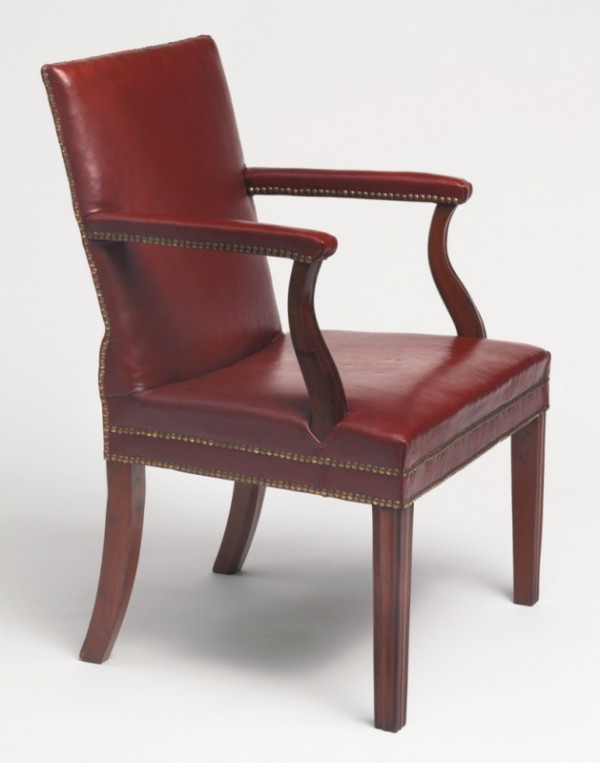
Armchair attributed to Thomas Affleck, Philadelphia, Pennsylvania, 1790–1793. Mahogany with oak. H. 34 1/4", D. 24", W. 24". (Courtesy, Philadelphia Museum of Art, gift of Henry P. McIlhenny, 1977.) The federal government hired Affleck to produce chairs and desks for the House and Senate chambers at Congress Hall, the former Philadelphia County Courthouse.
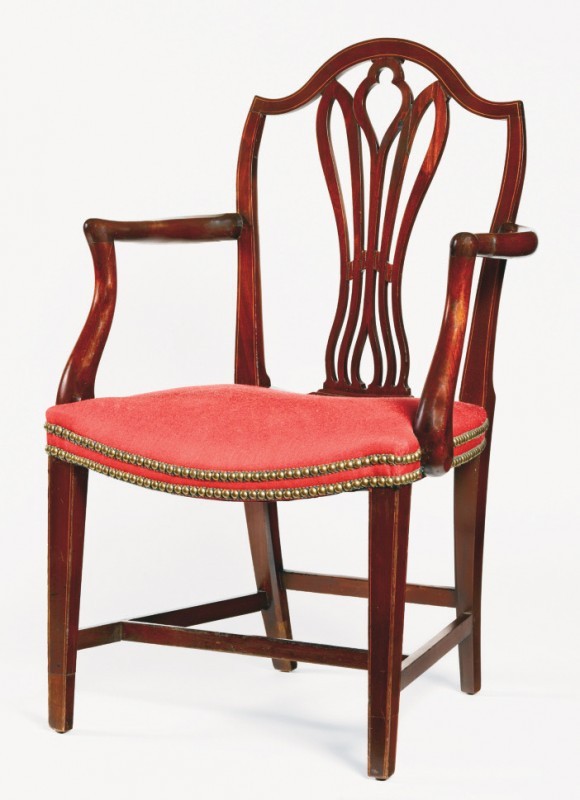
Armchair attributed to John Shaw, Annapolis, Maryland, ca. 1797. Mahogany and lightwood inlay with tulip poplar. H. 37 1/2", W. 23 1/4", D. 19". (Courtesy, Maryland State Archives.) This chair is thought to be from a set of twenty-four mahogany examples commissioned by Maryland’s state senate in 1797.
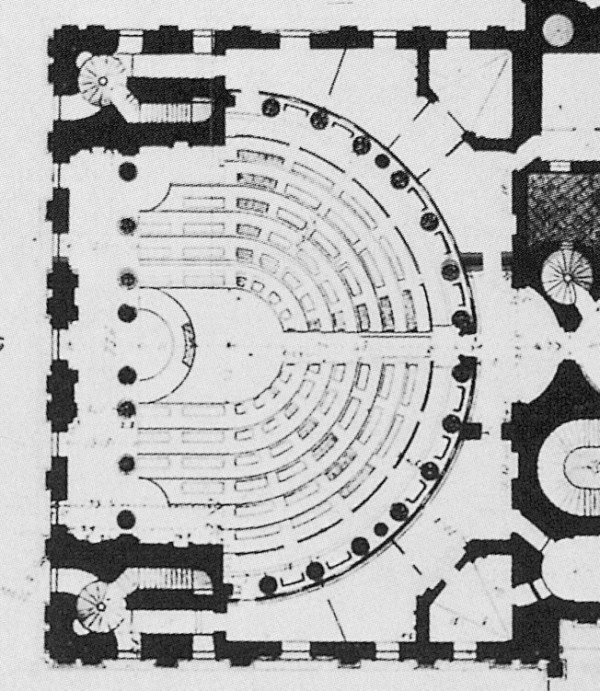
Detail of Alexander Jackson Davis’s plan of the first floor of the United States Capitol, Washington, D.C., 1832–1834. Drawing on paper. (Courtesy, Library of Congress.) Davis’s measured drawings of the Capitol are considered the most trustworthy depictions of Latrobe and Bulfinch’s finished work. This view of the House chamber confirms the arrangement of desks on stacked risers as seen in Morse’s painting (fig. 13).
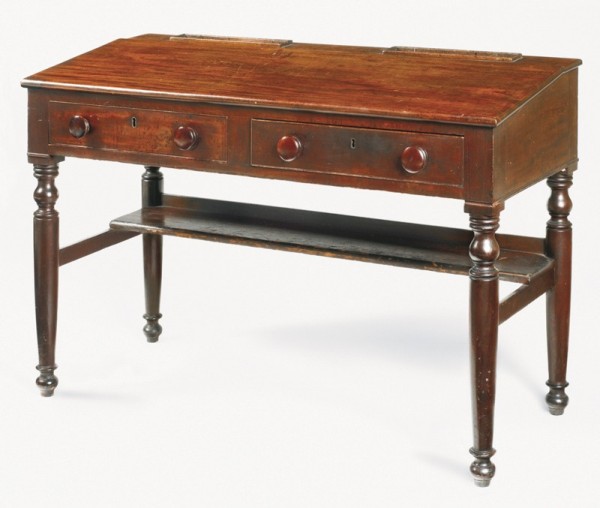
Desk attributed to T. Constantine & Co., New York City, ca. 1819. Mahogany with white pine and tulip poplar. H. 30 1/8", W. 47 1/2", D. 20 1/2". (Courtesy, National Park Service, Frederick Douglass National Historic Site; photo, Gavin Ashworth.) This two-person, straight-front desk is one of six that sat next to the rostrum used by the speaker of the House of Representatives (fig. 19). Most representatives shared a desk with at least one colleague, each having use of a drawer and shelf space. The turned legs resemble those on the House chairs (fig. 15).
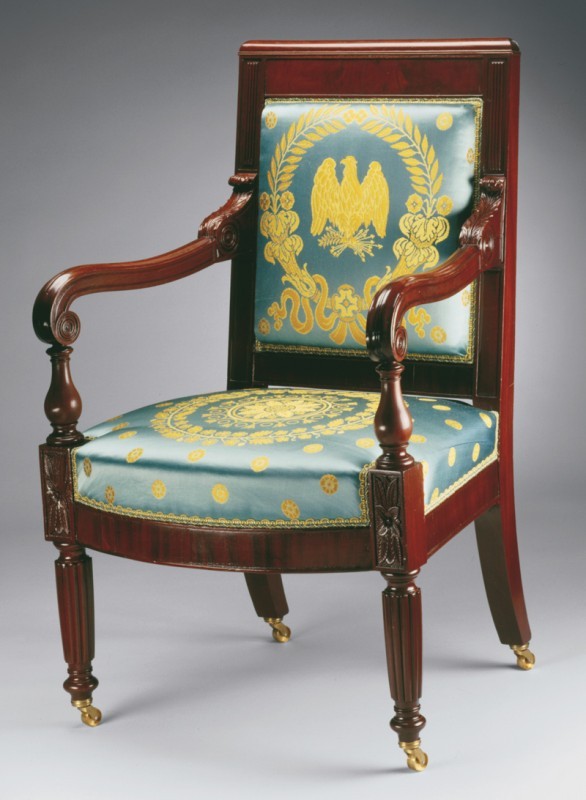
William King Jr., armchair, Washington, D.C., 1818. Mahogany and mahogany veneer with oak, ash, and tulip poplar. H. 41 1/4", W. 25 1/2", D. 25 3/8". (Courtesy, White House Historical Association.) In addition to ordering French furniture for the President’s House, James Monroe patronized local cabinetmakers such as King, who designed a suite of twenty-four chairs and four sofas for the East Room.

Details of the arm supports from chairs by T. Constantine & Co. (a) armchair illustrated in fig. 23, (b) armchair illustrated in fig. 24, (c) armchair illustrated in fig. 35. Variations in the carving of a and b confirm that Constantine either had multiple carvers working on the Senate commission or that he outsourced work to other shops. The arm support on the far right is from a chair modeled after the same Hope design as the Senate chairs, but the ornament is more florid.
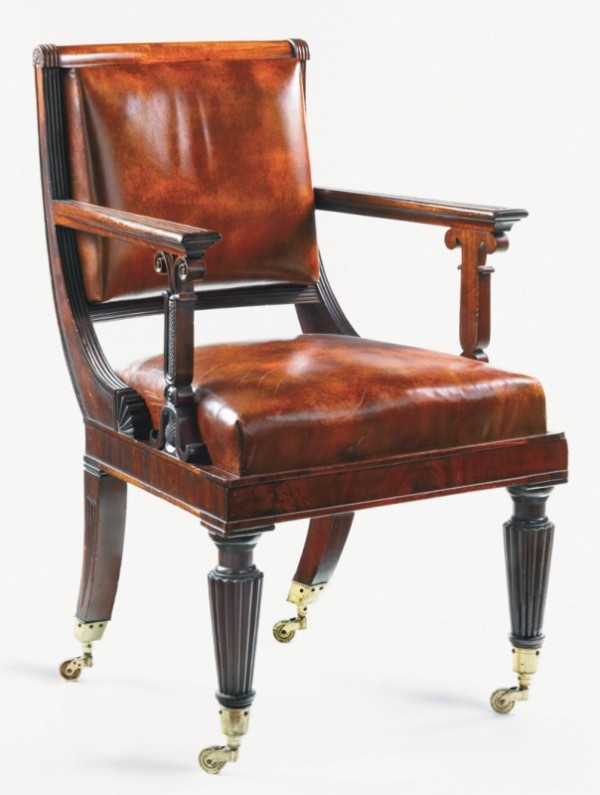
T. Constantine & Co., armchair, New York City, ca. 1819. Mahogany and mahogany veneer with maple. H. 38 5/8", W. 23 1/4", D. 19 1/2". (Private collection; photo, Gavin Ashworth.) This chair descended in the family of Senator Jonathan Chace (R-Rhode Island, 1885–1889).
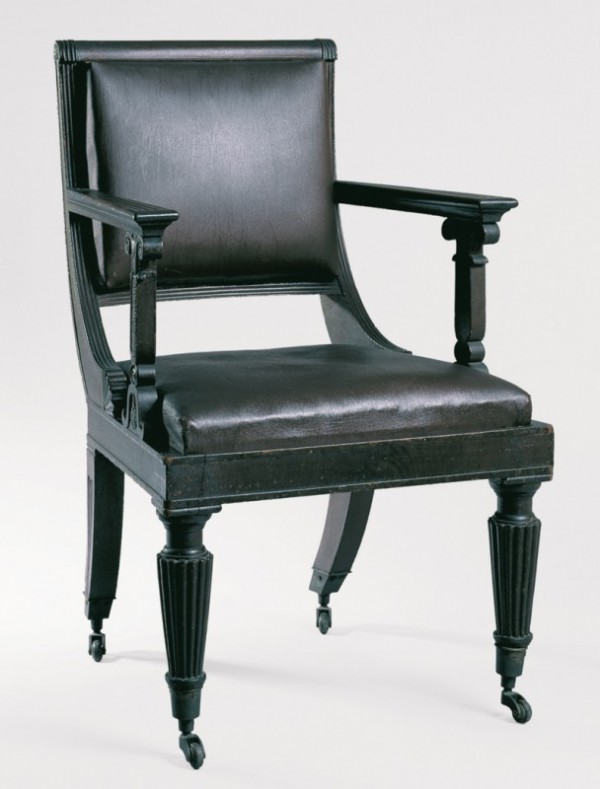
Armchair attributed to T. Constantine & Co., New York City, ca. 1819. Mahogany and mahogany veneer with maple. H. 38 3/8", W. 23 1/4", D. 19 1/2". (Private collection; photo Howard Agriesti.) Senator Hannibal Hamlin (R-Maine, 1857–1861, 1869–1881) took this chair home when he retired, and it remains in his family today.
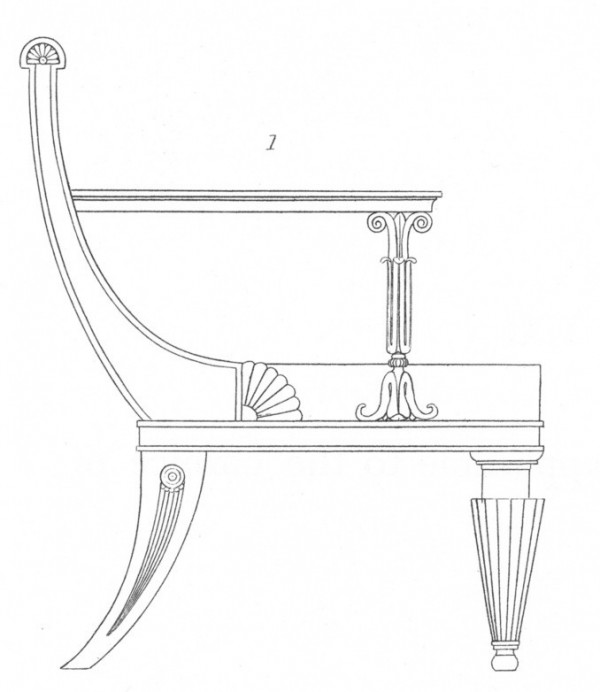
Design for an armchair illustrated in pl. 59 of Thomas Hope, Household Furniture and Interior Decoration (London, 1807). The design of the Senate chairs was based on this image.

Desk attributed to T. Constantine & Co., New York City, ca. 1819. Mahogany, mahogany veneer, and rosewood veneer with mahogany, tulip poplar, white pine, and ash. H. 35", W. 24 1/2", D. 19 3/16". (Courtesy, U.S. Senate Collection.) This is the only T. Constantine & Co. desk that did not have a supplementary writing box added above the original top in the second half of the nineteenth century. Plinths were placed under the trestles to raise the desk to the height of those with a writing box. Shelves were inserted beneath the desks in the 1830s.
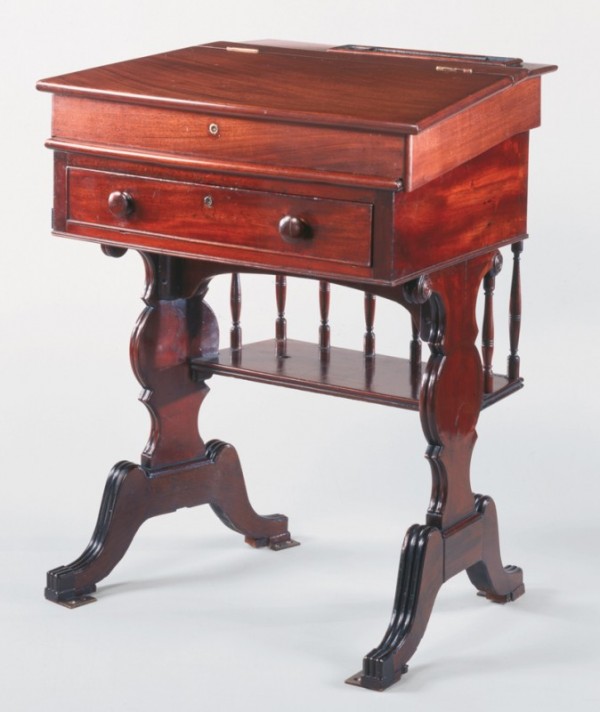
Desk attributed to T. Constantine & Co., New York City, ca. 1819. Mahogany and mahogany veneer with mahogany, tulip poplar, and white pine. H. 35 3/4", W. 29 1/8", D. 20 1/8". (Courtesy, U.S. Senate Collection.) The right side of this desk is angled to conform to the curve of the risers in the Senate chamber (see fig. 30).
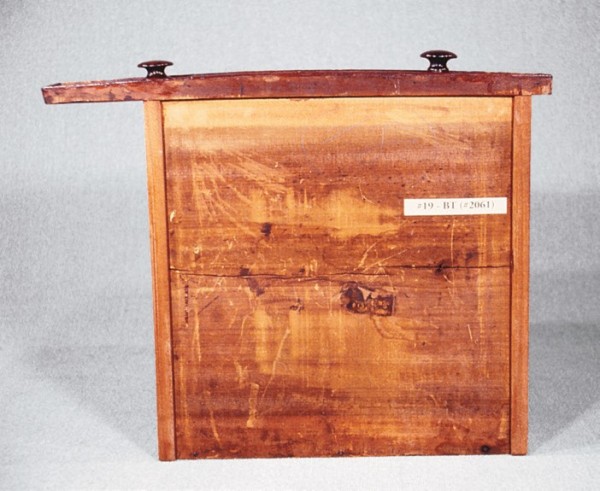
Detail of a drawer from the desk illustrated in fig. 27.
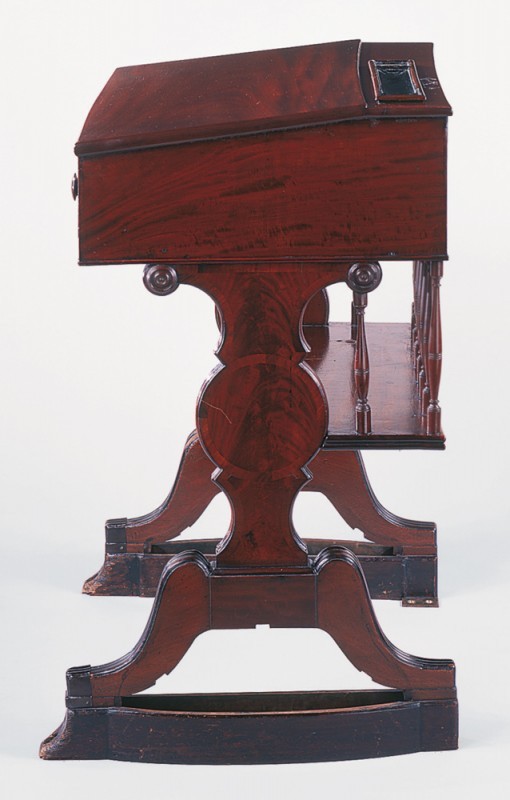
Detail of the side of the desk illustrated in fig. 26. Constantine selected elegant veneers for the Senate desks, including figured mahogany for the panels and mahogany or rosewood for the circular crossbanding.
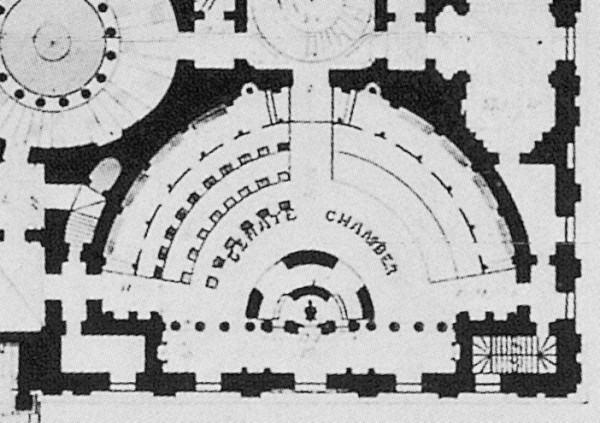
Detail of Alexander Jackson Davis’s plan for the first floor of the United States Capitol, Washington, D.C., ca. 1832–1834. Drawing. (Courtesy, Library of Congress.) As with Davis’s plan of the House, this drawing accurately reflects the distribution and orientation of desks on the Senate floor.

Design for a table illustrated in pl. 20 in Thomas Hope, Household Furniture and Interior Decoration (London, 1807). The concept for the circular, crossbanded reserve on the Senate desk may have come from this trestle table design.
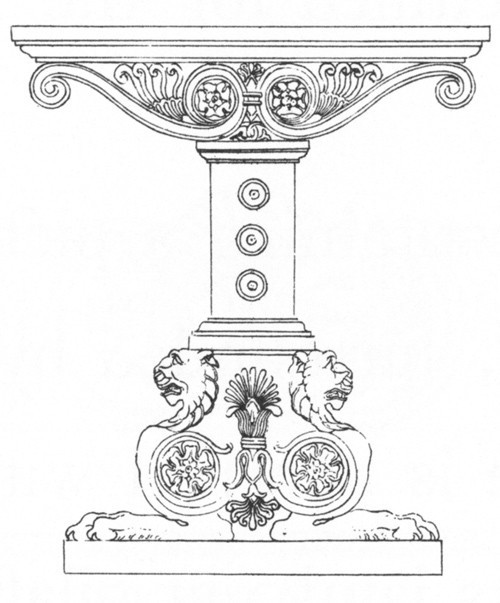
Design for a table illustrated in pl. 26 in Thomas Hope, Household Furniture and Interior Decoration (London, 1807). The scrolled top of this table may have influenced the design of the Senate desks.
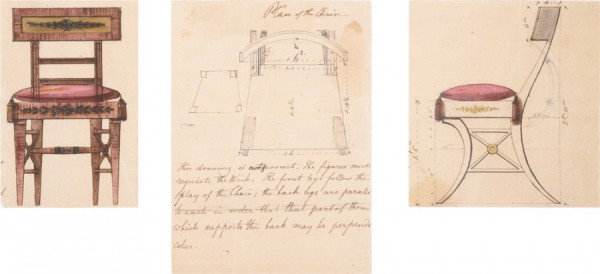
Benjamin Henry Latrobe, drawing for a chair for the President’s House, 1809. Watercolor on paper. (Courtesy, Maryland Historical Society.) James and Dolley Madison commissioned Latrobe to design a suite of seating furniture for the President’s House, which was lost when the British burned Washington during the War of 1812.

Detail of the painting illustrated in fig. 13. Benjamin Henry Latrobe designed this chandelier and sconces in 1818 for the House of Representatives. The New York firm of Irving, Smith & Hyslop ordered these lighting devices for the House from an unidentified manufacturer in Birmingham, England.

T. Constantine & Co., armchair, New York City, 1824–1825. Mahogany and mahogany veneer with maple. H. 37", W. 23 3/8", D. 19 3/4". (Courtesy, Winterthur Museum.) Though similar in appearance to the Senate’s seating furniture, this chair postdates the Senate commission and illustrates how Constantine continued to reference Hope’s Household Furniture later in his career.
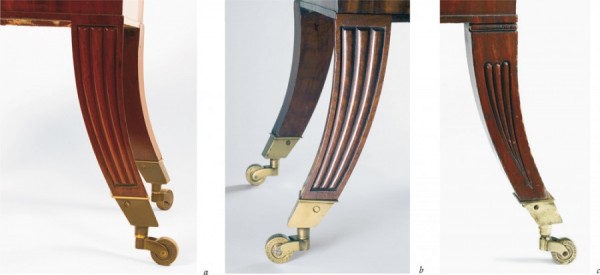
Detail of the rear legs from T. Constantine & Co. chairs: (a) armchair illustrated in fig. 35, (b) armchair illustrated in fig. 44, (c) armchair illustrated in fig. 24. The rear legs of the chair illustrated in fig. 35 match those on the Christ Church armchairs of 1824–1825 (fig. 44) and not the Senate’s seating furniture (fig. 24) or the North Carolina State Senate chair (fig. 43). This evidence supports a post-1823 manufacture date for the chair illustrated in fig. 35.
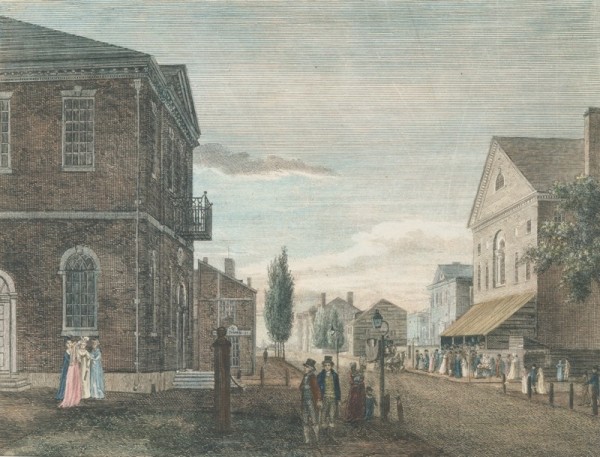
William Barker after William and Thomas Birch, “Congress Hall and New Theatre in Chestnut Street,” from The City of Philadelphia, in the State of Pennsylvania North America; as it appeared in the year 1800, Philadelphia, 1800. Engraving on paper, 13" x 15 1/2". (Courtesy, The Library Company of Philadelphia.) During the federal government’s ten-year hiatus in Philadelphia, the House and Senate convened at Congress Hall, which was built adjacent to Independence Hall between 1787 and 1789 and was originally intended to serve as the Philadelphia County Courthouse.
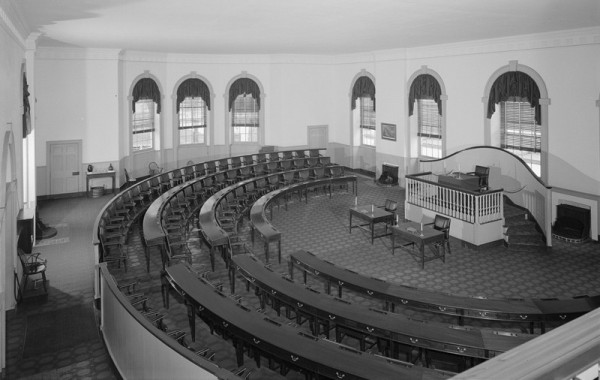
House of Representatives Chamber, first floor, Congress Hall. (Courtesy, Library of Congress.) Although none of Affleck’s House chairs and desks survive, their appearance is known through print sources dating to the 1790s.

Reproduction of an Axminster carpet by the Philadelphia Carpet Manufactory, Philadelphia, Pennsylvania, 1791. Wool with linen. 22' x 40'. (Courtesy, National Park Service, Independence National Historic Park.)
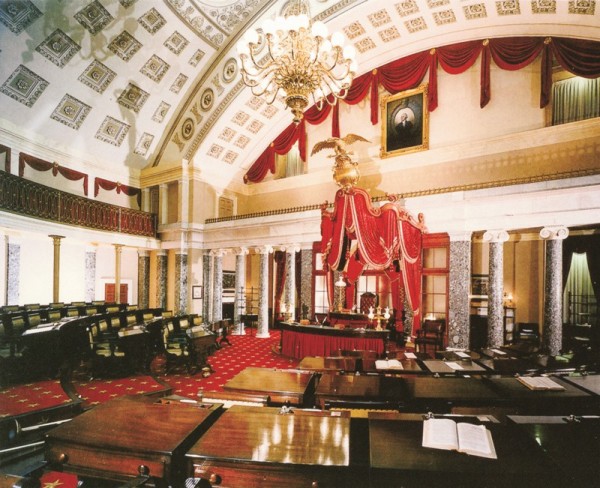
Old Senate Chamber. (Courtesy, U.S. Senate Collection.) The chamber was restored between 1973 and 1976 to resemble its crowded appearance in the 1850s. By 1850 sixty-two senators and their desks and chairs shared a room that Latrobe had designed for forty-eight.
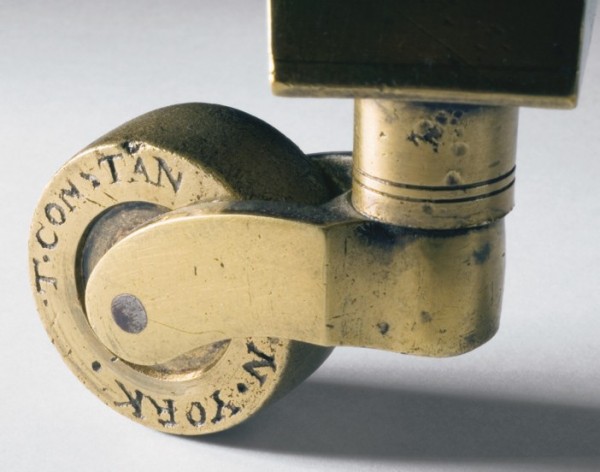
Castor, Birmingham, England, or New York, 1819–1825. Brass. (Courtesy, Winterthur Museum.) This castor is on a rear leg of the armchair illustrated in fig. 35. Identical castors are on the Senate chairs (fig. 23) and the armchairs for Manhattan’s Christ Church (fig. 44).
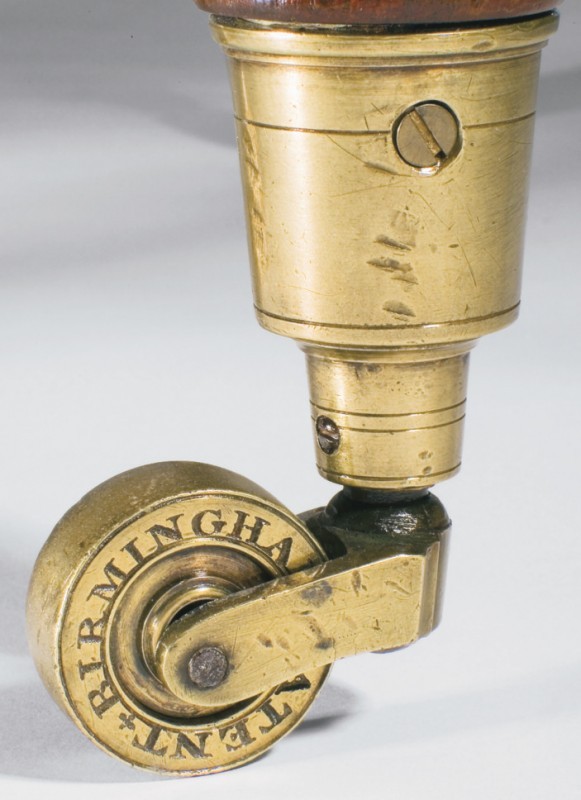
Castor, Birmingham, England, 1824–1825. Brass. (Courtesy, Winterthur Museum.) This castor is on a front leg of the armchair illustrated in fig. 35. This type of castor appears on the seating Constantine made for Christ Church, but not on furniture for the Senate commission.
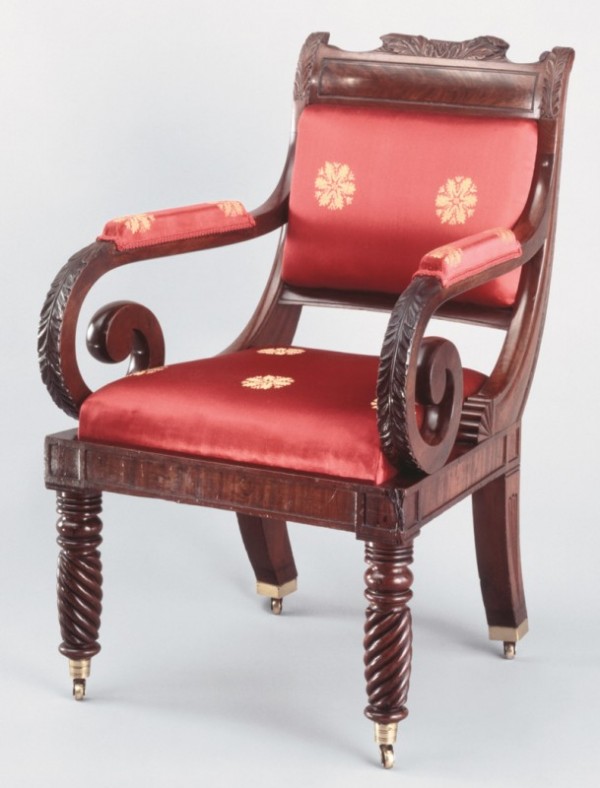
Armchair attributed to T. Constantine & Co., New York City, 1822–1823. Mahogany and mahogany veneer. H. 35", W. 25", D. 24". (Courtesy, North Carolina Museum of History.) Intended for the speaker of the North Carolina State Senate, this chair was included on John Constantine’s upholstery bill. The front legs below the seat rail are replaced, and none of the original castors survives. The chair is also missing brass mounts that were attached to the seat rail, arms, and crest.

T. Constantine & Co., armchair, 1824–1825. Mahogany and mahogany veneer with maple. H. 27", W. 17 1/2", D. 25". (Courtesy, Westervelt-Warner Collection of Gulf States Paper Corporation, Museum of American Art, Tuscaloosa, Alabama; photo Barry Fikes.) Constantine produced this armchair, one of a pair, for Christ Church in New York City. The chairs were probably for the rector and his assistant.

View of the Mills at Philipse Manor, ca. 1784. Watercolor on paper. 19 1/4" x 26 1/4". (Courtesy, Historic Hudson Valley, gift of La Duchesse de Talleyrand, PM.65.866.) In the late 1820s, after he closed his cabinetmaking business, Thomas Constantine owned the sawmill seen on the grounds of Philipse Manor.
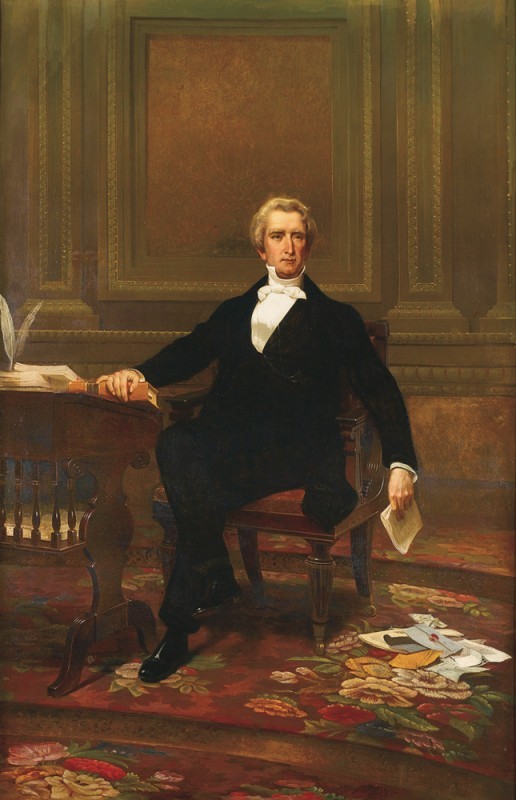
Emanuel Leutze, William Seward, 1858. Oil on canvas. 97" x 63". (Courtesy, Union League Club of New York; photo, Gavin Ashworth.) Seward (R-New York, 1849–1861) is shown seated in Thomas U. Walter’s new Senate chamber. The design of the chair and its castors suggest that Seward is seated in a T. Constantine & Co. chair from the Senate’s old room.
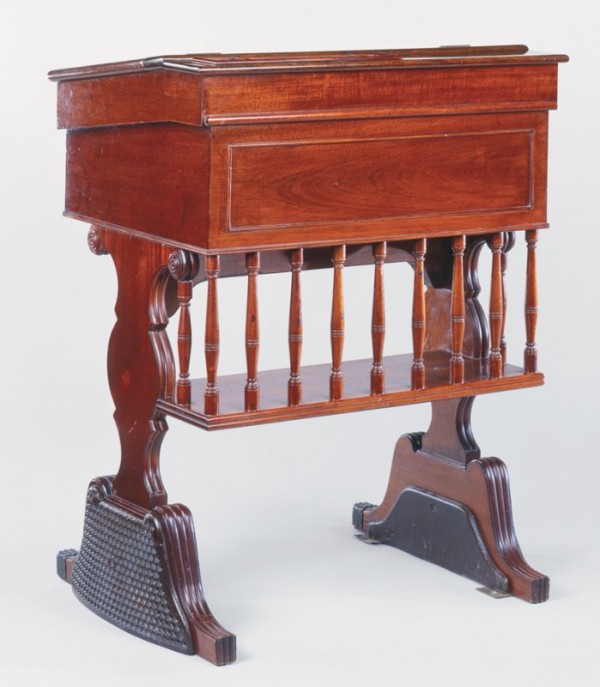
Roddiscraft, desk, Marshfield, Wisconsin, ca. 1959. Mahogany with mahogany, pine, and alder plywood. H. 35 7/8", W. 28", D. 20 1/4". (Courtesy, U.S. Senate Collection.) As new states entered the union, the Senate ordered additional desks. This particular example dates to the admittance of Alaska and Hawaii in 1959 and was constructed with the shelf, writing box, and metal grills as integrated components rather than as additions as are found on those attributed to T. Constantine & Co. (figs. 26, 27).

T. Constantine & Co., armchair, New York City, 1819. Mahogany and mahogany veneer with maple. H. 38 1/2", W. 23", D. 19 1/2". (Courtesy, Beauvoir, Jefferson Davis Museum and Memorial Library.) Jefferson Davis (D-Mississippi, 1847–1851, 1857–1861) reputedly used this chair in the Senate. The chair was destroyed during Hurricane Katrina.
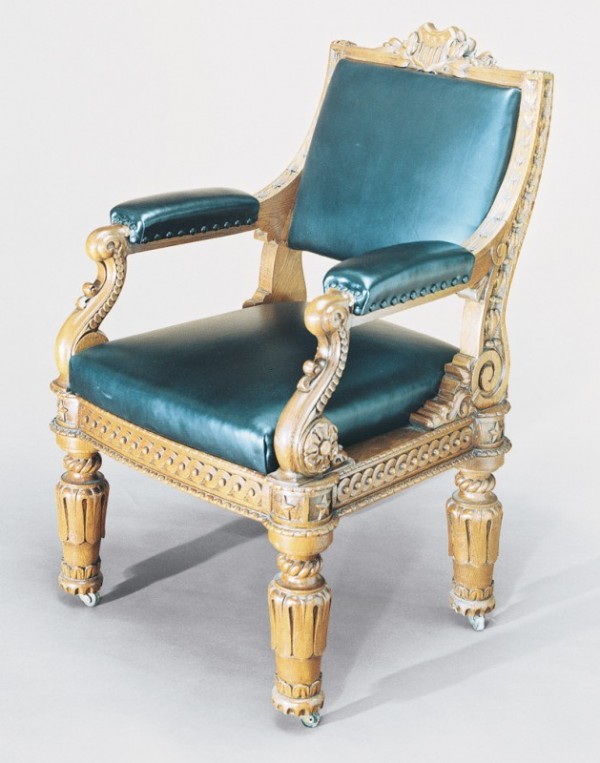
Bembé & Kimball, armchair, New York City, 1857–1858. Oak and oak veneer. H. 40 1/4", W. 25 1/4", D. 27 3/4". (Courtesy, Office of the Architect of the Capitol.) Thomas U. Walter, architect of the 1850s addition to the Capitol, designed this chair and others to replace the T. Constantine & Co. furniture in the House of Representatives chamber. John T. Hammitt’s Desk Manufacturing Company of Philadelphia manufactured half of the 262 chairs and Bembé & Kimball produced the remainder.
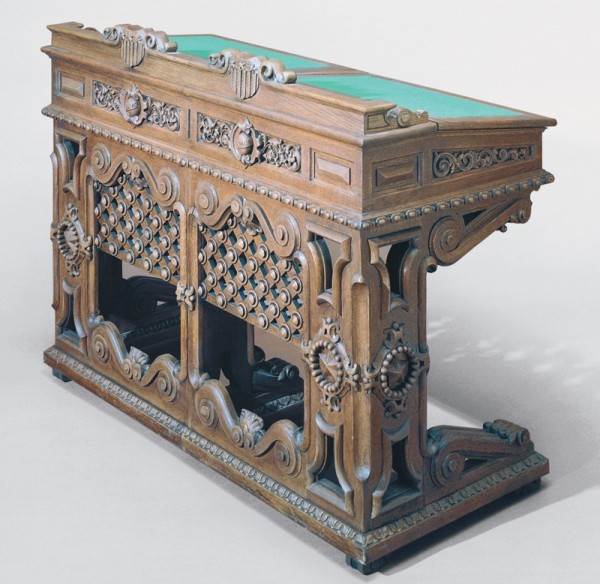
Doe, Hazleton & Co., desk, Boston, Massachusetts, 1857. Oak and oak veneer. H. 32", W. 46 1/2", D. 21 1/4". (Courtesy, Office of the Architect of the Capitol.) Thomas U. Walter designed this desk and others for the representatives’ new chamber. Doe, Hazleton & Co. furnished all 262 desks.
